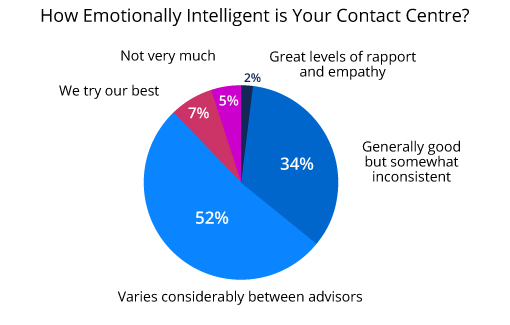These days, emotion and customer experience are pretty much “joined at the hip”.
So, as far as the service component is concerned, we need to start thinking, what can we do to stay more in tune with customer emotion in the contact centre?
Why is customer emotion so important?
Last year, research was conducted by Temkin Group which looked to identify specific emotions associated with call experience, time and transfer.
Unsurprisingly, the study found information such as that transfers tend to generate fear and anger in most customers. However, the results did uncover something far more interesting.
Emotion has the greatest impact on customer loyalty, more so than effort and success.
This is why contact centres are becoming increasingly eager to understand, measure and manage the impact that customer emotion has at important customer touchpoints.
The findings below highlight the impact success, effort and emotion has on customer loyalty, with:
- Success – Getting the outcome that the customer wants (e.g. first call resolution).
- Effort – The amount of effort the customer puts in to reach the end goal.
- Emotion – How the customer feels during and after the interaction.
The findings recorded by Temkin Group found that 78% of customers were likely to purchase from a company again after a successful interaction, 79% when there was little effort involved and 86% when the right emotions were evoked.
The results were similar when it came to NPS, with 52% of consumers giving high ratings after a successful interaction, 55% when there was little effort and 70% when good emotions were induced.

Martin Hill-Wilson
Martin Hill-Wilson, Founder of Brainfood Consulting, discusses these findings, stating: “It shows that we need to get more competent at understanding the emotions that we evoke from within customers.
“I am predicting that people will start to think about what this information really means and look for connections between emotion management and the commercial outcomes that they are trying to achieve.”
We need to improve the ability of advisors to understand what emotions are driving customer calls and devise ways that enable advisors to form a genuine connection with the caller.
Understanding your customers’ emotional drivers
Emotion influences the actions and behaviour of customers. So, the physical feelings that customer–agent interactions evoke will have a significant impact on their buying decisions.
As put by Nick Drake-Knight, “a key skill for contact centre professionals is to understand the thoughts and feelings a caller has as she makes her call.
“Customers will make a call if the emotional pay-off is sufficient to stimulate them to do so. They will if there is a strong enough emotional driver.”

Nick Drake-Knight
In his book, FAST COACHING: The Complete Guide to New Code Continue & Begin, Nick highlights two internal motivators that act as emotional drivers for callers when phoning the contact centre. These two are:
- Movement Away from Pain or Discomfort: including fear of potential future pain or discomfort.
- Movement Towards Pleasure: as feelings of relaxation, comfort or contentment.
Movement away from pain or discomfort
As noted above, this motivator is a caller’s planned movement away from anxiety, discomfort or from physical or emotional pain.
Nick adds that “it may be driven from a fear of future anxiety, that is, anticipating subsequent discomfort and physical or emotional pain. There is always unconscious processing activity going on.
“We react to our physiological, security and social needs in a manner which we (unconsciously) believe will remove or minimise unwelcome feelings. We respond as any sensible mammal would do – by moving away from pain.”
Movement towards pleasure
Whether for contentment, relief or for peace of mind, callers will have an explicit positive feeling that they want to retrieve.
Nick says that “Maybe it’s a feeling of contentment, of pleasure associated with recognition for achievement, of status, of security, of ego, or maybe exhilaration or excitement?
“What is the best, most accurate description (using the coachee’s language) of the pleasure which will stimulate their movement towards new behaviour?”
What does this mean for the contact centre?
So, when someone calls the contact centre, is it movement away from pain or movement towards pleasure?
Normally there is one dominant force, and if your call centre advisors can identify it, it will increase their chance of forging an emotional connection.
For example, if you can identify that the caller is moving away by expressing misdirected anger, the advisor can address this by using empathy statements to improve customer–agent rapport.
Nick recommends that your advisors ask themselves: “Is the caller driven by an urge to move away from discomfort? Or is she planning some pleasure? What is the emotional driver for taking action in making her call?
“Remember – callers take action for one or both of these reasons. What’s driving the call? What’s the dominant force? Movement away from discomfort or movement towards pleasure?”
So, now we can try to understand the caller’s motivations, what else can we do to improve the likelihood of forming an emotional connection with the customer?
For more advice on making your contact centre more emotionally intelligent, read our article: How to Improve Your Customer Service With Emotional Intelligence
Ways to improve your emotional connection with customers
Here we have some ideas to develop the emotional intelligence of your advisors to help them to build an emotional connection with callers.
1. Connect matching personality types
On a site visit to the British Gas contact centre in Cardiff, we learned that they categorised their staff members and customers into four personality types: controller, thinker, entertainer and feeler.

Once they matched an advisor with a personality type, the contact centre used the profiles to link an incoming call to an advisor with the same personality type as the caller, to enhance the possibility of an emotional connection.
For example, a ‘controller’ customer is somebody who wants their problem solved straight away, so they would not be keen to be involved in a conversation about the weather etc.
However, a thinker would probably appreciate having a little chat on the phone. So, if these two personality types meet on the phone, the chances of forming an emotional connection would be low and the advisor would have to adapt their personality.
Consequently, matching personality types can be beneficial, and you can find out how to implement this in your contact centre by reading our article: Using Personality Profiles to Personalise Customer Interactions
2. Try out reflective listening
Whilst many contact centres promote active listening, reflective listening could be advised as an alternative to boost engagement and forge an emotional connection.

Dave Salisbury
Reflective listening involves an advisor looking to understand the speaker’s idea and then repeating it back to the customer to ensure that it has been fully understood.
Dave Salisbury, Operations and Customer Relations Specialist, says this is important because “we must aim to achieve mutual understanding on every call. This requires going beyond simple active listening and rote phrasing into being engaged mentally in the process.”
For similar tips, read our article: Ten Tips to Improve Listening Skills on the Telephone or read How to Train Active Listening in the Contact Centre.
3. Repeat words that your customer uses
As well as repeating the customer’s ideas, advisors should also repeat adjectives that the customer uses, so the customer feel more “in tune” with them.
The following example involves the word ‘improve’, a word that the customer used when speaking. So, if the advisor were to repeat the word ‘improve’, which has positive connotations, there would be a greater chance of rapport.
Example: “Is there anything you can do to improve the speed of my broadband?” If you were to reply with: “I’ll have a look for you and see if there is anything I can tweak”, it will subconsciously confuse your caller because they didn’t say ‘tweak’; their chosen word was ‘improve’.
For similar advice, visit our article on Top Tips for Building Rapport on the Telephone
4. Know how to unhook after a rough call
We all have our own ways to recover from a bad experience, whether it is listening to a favourite song, watching a funny YouTube clip or something of that nature.
However, many of these or not practical on the call centre floor, so Dave Salisbury instead recommends that you practise deep breathing.
“Just keep breathing. I had several reps get emotional today, but the reps still need more training.”
Deep breathing is known to reduce stress, as it is naturally therapeutic. So, take a few moments and close your eyes and breathe in and out, exhaling after two seconds, to minimise your stress response.
This will prepare advisors for their next call, allowing them to start with a “clean slate” and to focus on forging a new positive emotional connection with the next caller.
5. Use positive words and empathy statements
Using scripts can often sound robotic and lacks any real warmth. However, you can replace a script with a list of positive words and empathy statements to give the customer a sense of optimism and suggest mutual understanding.
Empathy statements are particularly good at guiding advisors through handling an angry customer, as they are designed to create rapport with the customer and ensure that customer loyalty is not lost.
Also, these statements often include personal pronouns and active verbs, so the caller may feel enthused by knowing that there is someone looking out for them and that actions are being taken.
Lisa, one of our readers, says that her contact centre asks advisors to use such phrases, saying: “We call it partnership language – it is all about what we can achieve together. Our staff get one-to-one coaching to achieve this.”
For more tips and advice, please visit our article: 7 Ways to Build an Emotional Connection With Callers
6. Don’t let script adherence be a barrier to a positive emotional connection
When trying to establish an emotional connection with the customer, advisors should be able to use their emotional intelligence to decide when departing from the script will lead to a better customer outcome.

Frank Sherlock
For example, if a customer has not had their problem resolved is asked: ‘Is there anything else I can help you with today’, it is likely to be met with a negative response.
Unsurprisingly, this kind of misjudgment doesn’t deliver a successful call outcome, as the customer hasn’t been helped yet.
– Thanks to Frank Sherlock at CallMiner
For more advice on this subject, read our article: How to Develop the Best Script for Your Call Centre
More Tips from Our Readers
Here are some more tips for building emotional connections with customers, as put forward by our readers and customer experience expert Sandra Thompson.
1. Take a Breath
You can control your emotions. They don’t have to be in charge of you.
You can control your emotions. They don’t have to be in charge of you. When you sense an emotion is rising – take a breath!
When we feel stressed, our ability to absorb information and concentrate on the customer’s problem decreases. A short breath can help us to refocus, as we look to rebuild that emotional connection.
2. Be Direct In Difficult Situations
When giving bad news, being direct is best. We want to be as crystal clear with our information as possible – don’t wrap it up.
Stressed customers want clear guidance, so we don’t want to leave any room for confusion. Just remember, show empathy and be direct.
3. Motivate Advisors With a Purpose

Sandra Thompson
Give advisors a sense of purpose. Show them that what they do makes a difference.
Don’t just tell an advisor they should build emotional connections, tell them why. If we don’t do this, advisors may lack the enthusiasm to do so with every customer.
Thanks to Sandra Thompson at Exceed All Expectations
Find Sandra’s advice for applying emotions to customer experience in our article: Creating Memorable Customer Experiences With Emotional Intelligence
4. Create Emotional Connections With Your Team
Lead by example. If you treat your team well and make emotional connections with them, that will encourage similar behaviours from advisors.
When my advisors have uncontrollable issues, I listen to them, let them know I am here to assist them get through it and that I will get an answer for them.
Thanks to Vicki
5. Understand Customer Motivations
Making emotional connections with angry customers can be difficult, but the first step is to avoid confusing anger with fear.
A customer may be scared about something else going on in their life, it is rarely personal.
Sometimes a customer may be scared about something else going on in their life, it is rarely personal. Advisors must recognise this and manage their emotions accordingly.
Thanks to Lisa
6. Start a Well-Being Initiative
Emotional well-being is closely linked to physical well-being. If advisors are doing things to stay fit at work, hopefully we can re-energise their ability to build emotional connections.
We have provided pedometers for our advisors and encourage a weekly step challenge to help with wellness/stress along with a little “healthy” competition.
Thanks to Susan
7. Picture the Customer on the Other End of the Phone
Picture the customer in your mind as you listen and don’t be afraid to use body language when you talk, as this will be positively reflected in your tone of voice.
Using tips like this will help build sincerity. But, we must also remember that simply listening to them is key in how to best respond to them.
Thanks to Cindy
Final Thoughts
As the results from Temkin Group’s research suggest, the emotions that we evoke in a customer service role have a great impact upon customer loyalty.
Yet, according to a Call Centre Helper Poll, the majority of those in the industry, 52%, believe that advisors in their contact centre vary considerably in levels of emotional intelligence.

Hopefully, with the advice provided in this article, we can start to implement some of these ideas and help make contact centre teams even more emotionally intelligent.
Find out more about customer emotions by looking over the following pieces of great content:
- 7 Steps to Evoke the Emotions You Want From Your Customers
- How to Measure Customer Emotion
- Podcast: How can you use customer emotions to your advantage?
Author: Robyn Coppell
Published On: 29th Mar 2017 - Last modified: 14th Aug 2025
Read more about - Skills, CallMiner, Dave Salisbury, Emotion, Empathy, Language, Listening, Martin Hill-Wilson, Rapport, Skill Development



















